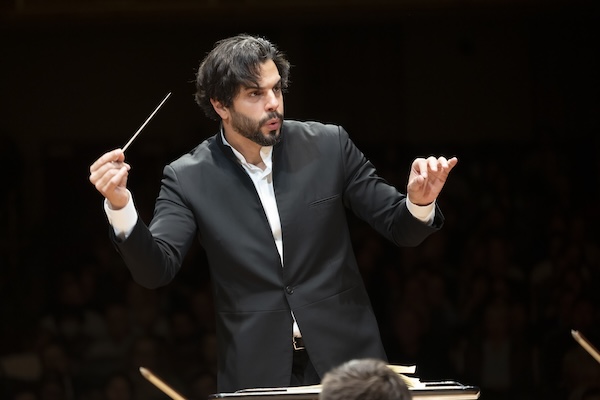Hindoyan makes impressive BSO debut leading Sierra premiere, Elgar and Dvořak
If the two immediate standing ovations on Thursday evening were any indication, sometimes the only response to a performance is “Again!”
Such was the case at the Boston Symphony Orchestra’s performance on Thursday night at Symphony Hall, where conductor Domingo Hindoyan and cellist Pablo Ferrández provided a program characterized by deep emotion expressed with stunning clarity.
Thursday’s program featured Roberto Sierra’s Sinfonía No. 6, Elgar’s Cello Concerto, and Dvořák’s Seventh Symphony in D minor. Hindoyan’s strength of interpretation illuminated the formal features of each piece on the program, as well as their place within the broader musical traditions. The result was a program of great interest, strong contrast, and sweeping power. Hindoyan’s leadership celebrated each individual player and the ensemble at large.
The evening opened with the American premiere of Sierra’s Sinfonia 6, co-commissioned by the Boston Symphony and written for Hindoyan. Sierra conceived of the piece in part as a dialogue with Beethoven’s Pastoral symphony. With its strong roots in both the classical tradition and the music of Latin America and the Caribbean, the work explores how the sounds and movements of nature shape the music made by the people who inhabit that landscape.
Sierra’s work is a showcase for the Boston Symphony Orchestra players—and in particular, the percussion section. Hindoyan led the ensemble with skill and panache in the “Reflexión Urbana.” The complex rhythms and interventions of the opening movement made the rapport between orchestra and the podium immediately evident.
With the second and third movements, “De Noche” and “Huracàn” the listener travels from the city to the country, and also to Beethoven. The third movement, “Huracàn,” was a fascinating reflection on Beethoven’s famous thunderstorm in the pastoral symphony. The brass and percussion led the charge here, with the trombones driving the chaos of the third movement into a thrilling conclusion in the piece’s final movement.
Sierra’s symphony was followed by Elgar’s Cello Concerto—an inspired programmatic choice that highlighted the pieces’ alternative approaches to musical texture.

Pablo Ferrández performed Elgar’s Cello Concerto with the BSO Thursday night. Photo: Michael J. Lutch
In the Elgar, soloist Ferrández displayed stunning virtuosity, with the orchestra and soloist each driving the other to greater heights. The opening solo—heart-rending in its lyricism and power—immediately telegraphed Ferrández’s commitment to the emotion of the piece. Following the intensity of this first movement, Ferrández conveyed the light playfulness and technical agility of the second movement.
In addition to Ferrández’s solo skill, Hindoyan’s attention to the details of the piece—balance, orchestral support, and rhythmic clarity—set off Ferrández’s interpretation and made the concerto especially cohesive.
The program closed with Dvořak’s Symphony No 7 —a finale that allowed the orchestra to show its full power following the more supportive role they played in the Elgar. Like the Sierra, Dvořak’s symphony maintains an interest in traditional symphonic form even as it engages with the music of the composer’s Czech homeland.
Hindoyan’s interpretation was brilliant here. In the hands of less able conductors, this piece can spiral out of control, losing thematic clarity and dynamic shape in its richness. Hindoyan’s reading, which scrupulously maintained the score’s crisp rhythms and judiciously meted out the orchestra’s power, made for a compelling performance in which nothing felt neglected or overwrought.
The Dvořák was further characterized by superb section and solo playing. Throughout the symphony, the horn section was an intrepid force, with beautiful solo work by principal horn Richard Sebring. The winds were also on fine display here, with principal flutist Elizabeth Rowe and principal oboist John Ferrillo forming a powerful duo. The cellos, too, led by principal Blaise Déjardin, contributed many striking section solos to Thursday night’s performance.
Following the exciting first movement and charming second movement, the Scherzo and fourth movement Allegro were highlights of the evening. Hindoyan balanced the blended textures with a particular attention to individual playing.
This program will be repeated 8 p.m. Saturday. bso.org
Posted in Performances


